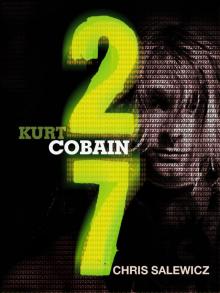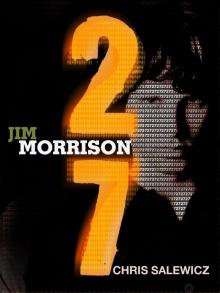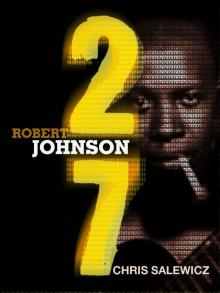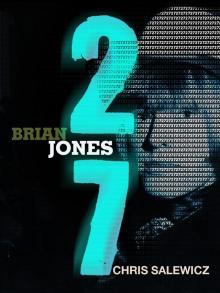- Home
- Salewicz, Chris
27: Brian Jones Page 4
27: Brian Jones Read online
Page 4
‘I don’t think I felt the band were judgmental about Brian. They were just affected. They’d find themselves without him. And they had to do a show, and this was at a point in their career when everything really counted. If one member of the group is seriously dysfunctional, the impact on everybody else is … he’s putting everybody on the line. I remember Stu grabbing him once in the wings as he came off and lifting him off the ground, and telling him that he was letting everybody down, not just himself.’
‘During this nine-week tour, I began to see this other side of Brian. In Florida they broke for a couple of days. Anita Pallenberg joined Brian there, and then left after a couple of days. But he invited me up to his room, and he said, “I’ve got two tabs of acid left, and I wonder if you would like to have one.” I said, “No, I’m not interested in acid, thank you very much.” So he said, “Oh, okay. I’ll tell you what: you take both of them and I’ll write down everything you say.” He was really out there, Brian. He was experimenting, he was ahead of them, he was freaking. In New York he was hanging out with Bob Dylan: that was the tour when there were the famous lost tapes when they were hanging out in his room. He introduced me to Bob Dylan. And then there was a tremendous power failure black-out and their idea of laying down a few tracks never happened. And they just got completely out of it. As everybody did that night. Brian was showing the character faults that he clearly had.’
‘He could be very interesting. He was capable of being incredibly charming and incredibly polite. Beautifully mannered. But then he’d turn, and he could be incredibly unpleasant. Very cliquey: he’d whisper in front of you, he and Anita would whisper. He loved to have the feeling that he had one over on you: that he knew something that you didn’t know. And there was something weaselly about him that made him difficult.’
‘However, the band seemed to forgive him his transgressions very, very quickly. It wasn’t like an irritating sore. Although I wasn’t privy to business meetings and discussions, and I don’t know whether there were moments when they all got together and had terrible screaming matches. But certainly the feeling was that they forgave him, and that everybody was trying to work together. And when it all worked, it was fantastic. I think that was what was holding everything together. When it all gelled, it was so good – and Brian was such a crucial and integral part of that. Brian had this huge fan base, and his fans were more focused. And it made it more important to try and live with his oddness. But the seeds were being sown.’
‘And the other thing that happened, which I think caused terrible problems for Brian, was that Mick and Keith were writing. And Brian couldn’t. People who were intimate with that whole group have confirmed to me that Brian couldn’t write. He was an excellent musician, a very versatile musician, a natural and instinctive musician, and a huge and crucial part of the Rolling Stones, but not being able to write was a big, big problem for him. And that he must have known even if he couldn’t really comprehend it or deal with it. He must have know that Mick and Keith writing, Mick singing, and Keith basically being the lead guitar meant he couldn’t maintain his position of being the leader of the band. And I guess that was really important to him, that status.’
‘I think it’s a real myth that Brian was plotted against. I honestly don’t believe that’s the case. I think that Brian sowed the seeds for his demise. And that he was responsible for it. Andrew instinctively knew that Mick and Keith were the soul of the band – although musically Charlie and Bill were the roots. And Brian was marginalized. Brian was this freaky, blond bomber. And played up to that. Perhaps he was pushed into that role more simply by what was going on.’
In many ways Brian created the template for the British musician who adopts a ‘rock ’n’ roll lifestyle’, with all its inbuilt self-destructive potential. ‘He was certainly ahead of everyone in terms of drugs and drink and possibly sex,’ said Mankowitz. ‘Mick and Keith had to write quite a lot, when they got a chance, because they were recording the Aftermath album at the end of this tour, at RCA studios in Hollywood. It was very exciting, because it was so new and different. But an awful lot of it was laborious and dreary, and not a great rock ’n’ roll life at all. ‘
*
At the beginning of 1966, however, the public face of the Rolling Stones remained that of Brian Jones. Brian’s image as the smug, flaxen-haired fop dominated photographs of the group and in live shows held the audience’s attention. Despite Mick’s reindeer-like onstage prancing, Brian – one minute still and silent, the next a smirking satyr – simply oozed moody charisma, even though his considerable talent increasingly seemed to have been reduced to little more than an engine for expressing such histrionic glamour. His curiously waddling form notwithstanding, Brian looked fantastic. He was the personification of rebellious, dandified decadence, and therefore the personification of the Rolling Stones. In a group sold as definitively ‘longhaired’, ‘Mr Shampoo’ was the only member who really was.
Despite the fact that the group were now utterly dependent on their increasingly original and catchy songs, to the fans Mick and especially Keith were mere also-rans next to Brian. This was a fact of which the pair were only too aware. The majority of the record-buying public had no inkling of the increasingly tempestuous internal politics within the Stones and, apart from the vocals and drums, hadn’t a clue as to who contributed what to the group’s sound and arrangements.
Now, in Anita Pallenberg, the group’s founder had also scored a definitive piece of ‘luxury crumpet’, a status symbol ‘bird’ whom he was already beginning to discover was at least his match. Half German, half Italian, Anita seemed unutterably exotic to the boy from Cheltenham, as well as to the boys from Dartford. She had worked with the Living Theatre, a long established, New York-based experimental theatre group; whilst in New York, she had had a long relationship with the postmodernist Italian painter Mario Schifano. As long as their relationship lasted, Brian Jones and Anita Pallenberg were the Number One Beautiful Couple in Europe. No matter that Brian – asthmatic, unfit, and increasingly unhinged by his drug and alcohol intake – had spent his first night with Anita sobbing paranoically over the way he said he was treated by Mick and Keith. As ‘top-notch totty’, rather to Mick’s chagrin, Anita left his own girlfriend Chrissie Shrimpton, sister of supermodel Jean Shrimpton, in the starting blocks. For his own part, Keith’s relationship with Linda Keith, was virtually on the rocks: Linda’s fondness not only for marijuana, but increasingly for the downer prescription drug Mandrax and now heroin – which Keith had so far resisted – had placed strains on their relationship that seemed impossible to resolve.
Meanwhile, Brian’s sexual indiscretions were catching up with him. A News of the World banner headline trumpeted on 16 January 1966: THE GIRL WHO LOVED A ROLLING STONE, a story detailing his desertion of Pat Andrews and their son Mark. Finally Pat Andrews was given a paternity order, with the magistrate ordering Brian Jones to pay £2.50 a week – the maximum award permissible – towards Mark’s upkeep.
*
Most days when he was in London during the spring and summer months of 1966, Keith Richards would walk the three or so miles from a flat he had rented on his own in St John’s Wood – where he had been pressured by the landlords to ensure fans made less noise – across Hyde Park to 1 Courtfield Road, behind Gloucester Road tube station. There Anita Pallenberg had bought a flat, into which Brian had moved. Keith’s problems with Linda had led to him feeling very much alone, and now he bonded again with Brian, as they had in the days when the two of them had been left alone in Edith Grove as Mick continued his studies at the LSE. Despite the fact that for the group’s audience Keith Richards remained almost entirely overshadowed by Brian Jones, the boy from Cheltenham for now at least was seemingly his best friend. The intriguing high priestess aspects of Anita, who was rarely without a bag containing tarot cards, and occasionally the odd bone, held more than a small attraction for Keith. For Keith the intimacy of what became near to a
triangular relationship had positive consequences. By osmosis he picked up elements of Brian’s ineffable dress sense, transforming his appearance. Soon he would also take Brian’s girlfriend.
Christopher Gibbs, a fashionable Chelsea art and antiques dealer, had insisted to Anita that she must buy the Courtfield Road flat, which only had one room and a set of stairs leading to a minstrel’s gallery that formed a bedroom of sorts. Gibbs had stressed how extraordinary the place could be made to look if money was spent on it. Almost inevitably, in this drug- and ego-befuddled household, the necessary forward-planning had never taken place. The interior of the residence resembled a much more expensive version of the post-adolescent chaos of the flat in nearby Edith Grove. Mick, exhausted from the constant squabbling with Chrissie, hardly ever ventured over to 1 Courtfield Road. The atmosphere of grime and unwashed dishes was something he found distinctly unsavoury; and he could not avoid picking up on a palpably unhealthy sexual tension that seemed to sit thickly in the air along with the fumes of best quality hashish. For some of those louche aristocrats who loved to hang out with dandy pop stars, however, 1 Courtfield Road became the epicentre of their world. Tara Browne, the Guinness heir, would often be round at the flat, staying up half the night talking with the two Stones and Anita before disappearing home in his Lotus Elan.
Christopher Gibbs was a central figure in a social milieu into which Mick, Keith and Brian had slipped with ease and which seemed to them to be daringly sophisticated. This was a world that now included such locations as Mrs Beaton’s Tent, a restaurant in Frith Street in Soho, run by an Australian called Michael Stafford, that became a favourite of the set. The arty world into which Mick, Keith and Brian had been drawn was sexually ambiguous, and often outright gay.
Anita introduced first Brian, then Keith and Mick, to Robert Fraser, a gay Old Etonian art dealer who was always on the cusp of the newest scenes. After having lived in New York with Mario Schifano for six months, Anita considered herself au fait with the Manhattan art world and therefore that of Europe. Through bohemian figures like John Dunbar, the heroin-addicted husband of Marianne Faithfull, and Barry Miles (known simply as Miles), who together ran the distinctly underground Indica Gallery and bookshop in Southampton Row, the Beatles had already fallen under Fraser’s spell. Now it was the turn of the Stones to take on Robert Fraser as their taste guru, although Mick usually claimed not to have the necessary money to buy any of the works Fraser offered him.
Robert Fraser also introduced Brian and Anita to the cosmic experience of LSD, the first person in London either of them knew who had taken acid. ‘I was just used to hash,’ said Anita, ‘but Brian and I one night at his place took this trip, went home and started to hallucinate.’ Soon Keith also discovered the secret of lysergic acid.
*
A friend of Robert Fraser was ‘Spanish’ Tony Sanchez, a photographer. He was such a fan of drugs that he could always come up with large quantities of the highest quality. As a man who could always be relied on to deliver the goods, Tony Sanchez soon became an indispensable part of Keith’s circle. ‘Like me, Keith was young and impressionable, and he had always been content to follow where Brian led,’ said Spanish Tony. ‘He turned Keith on to acid, and they were drawn together.’
Keith half-moved into 1 Courtfield Road, crashing on the couch or floor, aware of the sensuous and sometimes strange sounds floating down from the gallery above as Brian and Anita made love. As Anita had done to him, Brian turned his fellow Rolling Stone on to LSD, drawing them together, accentuating the endless musical improvisation in which they indulged. The axis shifted in the Stones again as it had done briefly at Edith Grove. Mick was regarded as the ‘straight’, because he hadn’t done acid, and confessed to being frightened of it. To further get his goat, Brian and Keith began to call him by his surname, which had the desired effect of really winding Mick up. At the same time Brian’s natural paranoia, exacerbated by his daily ingestion of drugs, made him extremely fearful of the evident close relationship and affection between Keith and Anita.
That the Rolling Stones had a strong creative wind behind them was proved irrefutably in April 1966 with the release of Aftermath. This extraordinary LP came as the climax of a golden period of Stones’ music, and Brian Jones was a crucial element of the sound, whose immediacy, clarity and distinctiveness could not be replicated by any other acts of the time. The clarity of production on these tracks is extraordinary, and the unique, fresh sound of Aftermath, the first album by the group to feature only Jagger-Richards compositions, can largely be attributed to Brian Jones’s startlingly original arrangements. The record’s instrumental line-up includes lutes, harpsichord, dulcimer, marimbas, sitar and bells – all played by Brian. If not capable of writing such songs as were on the album, Brian knew how to embellish them, enhancing them subtly with his esoteric instruments.
Brian also had his own, exclusive scene. In 1966 Alice Pollock and Sir Mark Palmer launched the English Boy model agency, ‘to change the image of British manhood and put the boy, as opposed to the girl, on the magazine cover in the future,’ said Palmer. Brian and Anita were on their books but never appeared in a shoot. Now Brian and Anita began to resemble the same person, Anita’s hair being cut in exactly the same androgynous pageboy style as Brian’s. For Germany’s Stern magazine, they did agree to pose for a set of photographs. Except that the ones they submitted featured Brian in an SS uniform, crushing a doll beneath his feet; next to the toy, at his feet, Anita cringed, trembling. Rejected by the magazine, the pictures all the same leaked out, appearing in the British press. ‘It was naughty! But what the hell! He looked good in an SS uniform!’ uttered Anita, years later.[22]
On 26 May 1966 all the Stones shared a box at Bob Dylan’s concert at the Royal Albert Hall. Earlier that evening they had performed a new single, ‘Paint It Black’, on Top of the Pops, which went out on the BBC at seven in the evening. Legendarily, Dylan shocked his folkie devotees when the already mythical troubadour returned for the second half of the show with his backing group the Hawks, soon to become the Band, and launched into the electric phase of his career.
Following the show, Brian and Keith went to Blaise’s nightclub, a few hundred yards away in nearby Queensgate, where Dylan later arrived. Nervously, Keith had approached him. With a sardonic sneer, Dylan looked straight through him and let fly: ‘I could write ‘Satisfaction’, but you couldn’t write ‘Mr Tambourine Man’.’ Drunk, Keith took a swing at Dylan, and a short melee ensued. Dylan returned to his hotel, followed by Brian and Keith. Brian was steering his Rolls Royce, intent on having another pop – Dylan slipped away from them. (Brian had purchased a personalized number plate for his luxury transport: DD 666. It was as though he was thumbing his nose at the deity.)
*
In the summer of 1966, Linda Lawrence appeared on the doorstep at Courtfield Road, accompanied by Julian, their son, and her mother. Keeping them away from partying revellers, including an excessively out-of-it Keith Richards, Brian took them up to his bedroom. After some two hours, they left, Brian visibly in a disturbed emotional state.
*
Following a summer tour of the United States, the Rolling Stones went on holiday. At the suggestion of Christopher Gibbs, Brian and Anita headed for Morocco. There, during one of their several fights, Brian broke his hand on a hotel bedroom wall when he took a swing at her.
This meant that when the group had to make a hurried flight to New York on 9 September to unexpectedly perform their next single, ‘Have You Seen Your Mother, Baby’ on the Ed Sullivan Show, along with ‘Paint It Black’ and ‘Lady Jane’, only Mick’s vocals were live. The group mimed to pre-recorded backing tracks. Brian, whose bandaged hand was clearly visible, had played the sitar that dominated ‘Paint It Black’ as well as the dulcimer on ‘Lady Jane’.
On 12 September, the Stones shot a promotional film in New York for ‘Have You Seen Your Mother, Baby’, in which the group appeared in drag, dressed like thir
ty-year-old women in the wartime 1940s. The same theme was employed in all publicity for the record, and ‘Molly’ Richards and ‘Sarah’ Jagger adorned the single’s poster, to great controversy. In the same image Brian, dressed in a World War II WREN’s uniform, wears his customary visage of stoned arrogance. Might he have appeared more modest if he had been aware that he would never again tour the United States with the Rolling Stones?
*
The end of the summer of 1966 was a pivotal time in the emotional lives of both Mick and Keith. To the consternation of Brian, who a few months previously had seized control of the awkward triangular relationship between himself, Keith and Mick, the Stones singer now began to hang out at Courtfield Road with Keith. The guitarist was beginning to acknowledge that he had smouldering feelings for Anita, a flame that burned brighter when he discovered precisely how Brian had hurt his hand. His innate psychic abilities heightened – and confused – by his drug intake, Brian was perpetually anxious that something was going on between Anita and Keith.
By now, moreover, it was hard not to pick up on the tension between Brian and Anita. When Brian ran into Ronni Money, the wife of his friend Zoot Money, the keyboardist and bandleader, in the Scotch of St James nightclub, Anita peremptorily ordered, ‘I don’t want you talking to this slag!’ Brian’s response was to punch her on the nose and tell her never to speak of Ronni in such a manner.
The 18th of December 1966 brought a major trauma that affected London’s chic young set to such an extent that it earned mention in one of the new songs being worked on by the Beatles. Brian’s good friend Tara Browne was killed in a car crash. He drove his Lotus Elan, the most chic of sports cars, straight into a parked truck in Redcliffe Gardens in nearby Earls Court. With him was his girlfriend Suki Potier. She was utterly distraught, and Brian provided personal care to her on a daily basis. ‘He gave me a shoulder to cry on and he picked up the pieces and made me feel a woman again,’ said Suki. Later, Brian would have a relationship with her: on and off, the pair dated for approximately two years.

 27: Kurt Cobain
27: Kurt Cobain 27: Jim Morrison
27: Jim Morrison 27: Robert Johnson
27: Robert Johnson 27: Brian Jones
27: Brian Jones